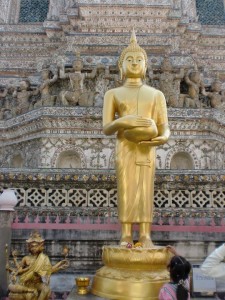The Emerald Buddha
The Emerald Buddha in the temple of Wat Phra Kaew, Grand Palace, Bangkok signifies Buddhism faith in Thailand. As people believe in Buddha and his teachings, the sacred image of the Emerald Buddha continually gives hope and inspiration. With every lighted candle stick, and with every prayer sent, Wat Phra Kaew temple seems to be divinely solemnized.
The legend of the Emerald Buddha started in the year 43 BC. According to the legend, Nagasena created the image in the City of Pataliputra, which is called Patna these days, in India. The Buddha remained in Pataliputra for three hundred long years. Civil war swayed, and the image was purposely taken to Sri Lanka to save it from the pending destruction.
Years went by and in 457 BC, King Anuruth of Burma supported Buddhism in his country during his reign and therefore commanded a mission to Ceylon to ask for some Buddhist scriptures and the famed Emerald Buddha. Fatefully, the request was immediately granted, yet during an angry storm the ship got lost on its voyage home and the storm made it land in the territory of Cambodia.
In 1432, the Thais had captured Angkor Wat and they took the Emerald Buddha to Ayutthaya, then to Kamphaeng Phet, then Laos and finally, in the grounds of Chiang Rai. Chiang Rai’s ruler, being wise, managed to hide the Emerald Buddha.
History, on the other hand, revealed another significant story. It was stated that, in the year 1434, the shimmering statue of the Emerald Buddha surfaced in Northern Thailand in the kingdom of Lannathai.
The discovery tells of one strike of lightning hitting a pagoda in a temple in Chiang Rai. Right after that momentous rainy night, something sparkling became visible underneath the stucco. It was the Emerald Buddha. The people dug the statue out and with sparkles of bright green colours, they believed it was emerald; hence its name.
The king of Lannathai, King Sam Fang Kaen, earnestly wanted the Emerald Buddha in his capital. However, on its way to Chiang Mai, the capital, the elephant carrying it insisted to go to Lampang in three different instances. This was taken as a heavenly sign; therefore, the image was brought to Lampang and stayed there until the year 1468. The Emerald Buddha was then moved to Chiang Mai and kept at the Wat Chedi Luang.
The Emerald Buddha lingered in Chiang Mai until 1552. Then it was taken to Luang Prabang, the capital of Lao in the kingdom of Lan Xang. Setthathirath, the crown prince of Lan Xang became King of Lannathai when the throne was vacant but afterwards became King of Lan Xang at the death of his father. This made the Emerald Buddha to be brought back home again and in 1564 was transferred to Vientiane.
The statue stayed in Laos for over 200 years, untilGeneral Chakri , Rama I, brought it back to the Thai capital at Thonburi after his successful campaign in Laos. In 1784, when the Thai capital was moved across the river, it was placed in Wat Phra Kaew, its temple, in the Grand Palace, Bangkok.
The Emerald Buddha with all its visited places still sits there perfectly, clothed in gold, is made of green jasper, not emerald, and is 45 centimetres tall.



Nice article, I have visited The Emerald Buddha a few times and never knew it’s amazing history.
Thanks very much
Thanks for the comment Murray. I am glad you liked the article.
Emerald Buddha statue as you mentioned can be considered as one of the important and oldest Buddhist sculptures. Yet the condition of Buddha statues are so beautiful and in top notch.
Beautiful Sculptures and Loved your article.